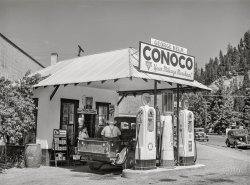
MAY CONTAIN NUTS

Search Shorpy
SHORPY ART

Framed or unframed, desk size to sofa size, printed by us in Arizona and Alabama since 2007. Explore now.
Join and Share
Ad-Free Shorpy
Shorpy is funded by you. Patreon contributors get an ad-free experience.
Learn more.

Recent comments
- Complicated then, forgotten now
- Bryan-Stevenson
- Skinny is as skinny does
- How do you rest in peace
- Riding the footboards
- Alas, hidden from view
- Baldwin Diesels
- Exclusive pump
- Bananas, Oysters and Smokey Joe
- Details, Details
- What's that building to the left of the tower?
- Coal Barges
- Bromo-Seltzer
- Inner harbor
- The Basin
- What a headache!
- Giant stepladder?
- Yeah, it was cold
- Love those coats
- Link & Pin Days Remnant
- Baldwin 62303
- Baldwin VO-1000
- Cold
- No expense spared
- Tough Guys
- Lost in Toyland
- And without gloves
- If I were a blindfolded time traveler
- Smoke Consumer Also Cooks
- Oh that stove!
Member Photos
The Shorpy
Print Emporium
Print Emporium
Search Shorpy
Search results -- 30 results per page
- Bless This Mess: 1939
- ... Bradford, Vermont. Orange County." Acetate negative by Russell Lee for the Farm Security Administration. View full size.
What's ... Posted by Dave - 07/18/2021 - 8:29am -
![Bless This Mess: 1939 October 1939. "Kitchen on FSA client farm home near Bradford, Vermont. Orange County." Acetate negative by Russell Lee for the Farm Security Administration. View full size.
What's in the bucket??it's Vermont, probably maple syrup.
Doesn't MatchPosition of Legs and Feet on the floor do not match the position of the person standing. There's somebody else hiding back there.
[Um, no. - Dave]
Disturbing MessOut of all the kitchen photos that have been on Shorpy over the years, I think this one is the most disturbing. I've eaten meals in some pretty "interesting" places, but I'd have to pass on an offer to eat there.
All of the FliesMy goodness, just look at that flypaper at top center of the image.
Two TimerSo, is it 12:17 or 12:38?
SingerBehind and to the left of our "homemaker" is a Singer sewing machine. I still have one identical to this that my Great grandfather bought for my great-grandma in 1913. It runs with a foot treadle and leather drive belt. I can still see Grandma using it as it ran at a blur.
At the end of her life, Grandma lived with us. One day she handed me a soft rubber grommet and told me to take it to the Singer store to buy another. The lady at Singer opened a drawer that was full of said grommets and handed me one.
The leather drive belt needs replacement and that rubber grommet is likely shot as well; but that old Singer looks pretty good after 108 summers!
Some nice antiques thereGood chance it's a Griswold #8 cast iron pan to the right of the sugar bowl and depression glass salt shaker. Wonder what's finger lickin good in that bucket??
Time to clean houseMy parents used to tell me that during those years, people couldn't help being poor, but didn't have to live like pigs. I guess this backs that up.
Singer DropheadThis is a drophead Singer treadle sewing machine from around the 1930s. Sewing machines such as this could be hidden making it appear like a fancy hall table.
Cinco de MesaThat table apparently has five legs, all on casters.
Singer stitchesMy maternal grandmother had a Singer that looked exactly like the one in a previous comment. As tiny kids, we were always curious about what she kept in those darned drawers. Mom told us to stay away from it as we would get stitches sewn into our hands if we weren't careful.
Looks Okay to MeIf you're not ever inviting guests over, why waste time deciding what to keep and what to throw away, so long as you don't run out of space. If they have a dog, he doesn't care either.
The messy live longer, after adding in the time saved not cleaning up.
Rich messy people have more expensive clutter, is all.
What clean meansI'm sorry but there's no excuse for living in squalor, no matter what the financial circumstances. Furthermore, filthy cannot be healthy. We were poor by most standards for a significant portion of my childhood, but my mother would not abide anything less than an immaculate house. Mama worked as a waitress, so from an early age my big sister and I were tasked with every chore there was: cleaning, doing laundry (wringer washer and clothesline), cooking, and child care (of the two littles). Our grades had better be up to snuff too, or else. Soap is cheap and elbow grease is free. Character is priceless. I don't say we were better than our slovenly counterparts, but we certainly were luckier.
Depressing . . . It's possible that a parent has died or is critically ill, leaving the child to fend for him/herself most of the time. The filthy windows and dead or dying plants and flowers; the Singer treadle machine piled high with papers; plates and skillets full of congealed grease; spilled food on the table; the well-populated flypaper — all would seem to indicate that the the mother of this family is missing in action. A profoundly depressing photo.
[Mama is alive and well and very busy. - Dave]
Farm Security Administration PhotosIt must be remembered that the whole purpose of the FSA photography project was to influence the policy makers and get them on board with the numerous New Deal schemes of FDR. If this kitchen was clean and well-kept, Russell Lee would never have photographed it.
[Not so. He photographed plenty of tidy kitchens. - Dave]
Messy KitchenAnybody who did not live during the Great Depression will never understand how bad it was.
(The Gallery, Kitchens etc., Russell Lee)](https://www.shorpy.com/files/images/SHORPY-8b22954a.thumbnail.jpg)
- Fairly Fun: 1942
- ... El Centro, California." Medium format acetate negative by Russell Lee for the Office of War Information. View full size.
What could go ... Posted by Dave - 06/15/2022 - 4:36pm -
![Fairly Fun: 1942 March 1942. "Boys. Imperial County Fair, El Centro, California." Medium format acetate negative by Russell Lee for the Office of War Information. View full size.
What could go wrong?Just as so many YouTube videos show now, guys and gals in this age group run around, absolutely convinced that nothing bad can happen to them; and never thinking five seconds into the future.
Not seriousWhile not saying that this lot would never try such a stunt, the photo is pretty clearly staged: There is no motion blur (especially in the wheel spokes), no dust being kicked up, and isn't the starter crank normally removed once the engine is running?
[Look closely and you will see the trailing halves of the wheels are indeed blurred. - Dave]
It's all fun and games for the moment ...I can't help but think about the fate of these young men, especially the driver, after seeing the date of this photo and wondering their fate. Pearl Harbor had just been attacked in Dec 1941, and on Feb 19, 1942 FDR signed Executive Order 9066 authorizing the Secretary of War to establish Military Areas in which persons of Japanese heritage began being evacuated to on April 11, 1942.
InternmentI wonder what happened to the young man driving? He looks as if he could be of Japanese descent, and to our shame, many families were placed in Internment camps across America from 1942 to 1945. That day, however, he was happy with his buds. Perfect moment in time captured for all time.
The Asian driverThis photo is dated one month after President Roosevelt's notorious Executive Order 9066, which resulted in the internment of 120,000 people of Japanese ancestry, mostly from California.
Not well known today is Life Magazine's December 22, 1941 article, "How to Tell Japs from the Chinese," which had the subtitle "Angry Citizens Victimize Allies with Emotional Outburst at Enemy."
I don't know what this young man's ancestry was, but I expect that, despite this joyride, he was having some tense times in March 1942.
Old GloryDid anyone notice the American flag decal proudly displayed on the Model T's windshield? I think these Imperial Valley teens were likely not shy about their patriotism, at an especially high-level during WW2.
Half-blurredHow would the front halves be still while the backs blur?
>> the trailing halves of the wheels are indeed blurred
[This has been the subject of considerable discussion here and elsewhere. It has to do with the direction the camera shutter is traveling (top-to-bottom, left-to-right, etc.) relative to the motion of what you're photographing. An effect especially pronounced in photos of cars and carriages made with the slower exposures and focal-plane shutters the glass-plate era, where we see only half of each wheel. - Dave]
The crankHaving recently owned a model T Ford, I can tell you that the crank stays in place when not in use. Note the coil spring on it. The crank must be pressed in to engage the crankshaft, then with the spark fully retarded, quickly cranked over. If done wrong, it can kick back possibly causing a broken arm. When done correctly, it usually fires right up and the spring retracts the crank out of the way. It actually works very well.
Re: Half-blurredBut, a focal plane shutter in a 1942 medium format camera? I would expect an iris shutter. And I really don't see an motion blur.
[Look harder. The Speed Graphics that made these photos used a focal-plane shutter. - Dave]
Aftermarket body?I see a door outline on the drivers side, but it doesn't seem to have a handle or hinges. Did Ford make them that way?
[Yes. - Dave]
(The Gallery, Cars, Trucks, Buses, Russell Lee)](https://www.shorpy.com/files/images/SHORPY-8c24282a.thumbnail.jpg)
- Beware of Cat: 1938
- ... sure this has only the one. 35mm nitrate negative by Russell Lee for the Farm Security Administration. View full size.
Looks like ... Posted by Dave - 07/09/2013 - 1:36am -
![Beware of Cat: 1938 September 1938. "Storefront in Altheimer, Arkansas." Lately I've been inspecting every new post for cats. I am pretty sure this has only the one. 35mm nitrate negative by Russell Lee for the Farm Security Administration. View full size.
Looks like early morningAnd the rodent exterminator is the first one to show up for work.
Petticoat Junction, here we come.This must be Hooterville. I think I can seem Sam Drucker peering out the winder -- er, window -- of his general store.
I paid for this new hat" ... with what I saved on ______ " What? Can anyone read the rest of the advertisement?
[Too fuzzy to make out -- Something Cigarettes? This is what happens when 35mm film replaces 8x10 glass plates! - Dave]
Cat's Meow?We have 27 "Cat's Meow" replica structures around the top of our kitchen cabinets. It look like Shorpy is getting into the business, too!
Domino CigarettesDomino Cigarettes were the "double mild" brand. Here's the same sign from a different photo in the same set (with contrast somewhat enhanced):
[Nice work. This is actually from the same photo I used to illustrate the comment below. -Dave]
Now I'm depressed...Altheimer may just be the most depressing place I've ever visited via Google Maps. But the masonry building on the right is still there!
I think:I'd beware of owner.
Second cat?I think there might be a second cat under the porch there, with its foot behind its head? or is my brain just copy-pasting cats now?
[Looks like a cat to me, too. -tterrace]
ZI wanted to go back to this store, but I forgot the way.
Retro PepperThis is the first time I have seen the throwback / real (beet) sugar packaging in the wild.
AwwwwKitty's giving her self a nice little wash. Looks like a tortoise shell from this blurry angle.
Some History Behind This PictureThe store pictured, apparently, was owned by a Chinese grocer. Altheimer's downtown has mostly disappeared, based on a look on Google Street View, though there is a dreary looking IGA that could be a descendent of this place. I wonder what the "Silver" place was across the street from the store.
Cigarettes are the closest thing to breadThe Butternut Bread ad on the right hand door's push bar, that is, with the Avalon Cigarettes sign to the right ("You'd never guess they cost you less"). Avalon Time was a comedy variety show sponsored by Avalon Cigarettes and broadcast from 1938 to 1940 on NBC, and it's where Red Skelton began his on-air comedy career. Their promotional gimmick on the radio was that because they cost less than popular brands, the spot ended with the imaginary cashier saying, "And don't forget your change!"
Here's an Avalon poster not exactly as Shorpy's but close enough:
Domino CigarettesI suppose it never occurred to the fans of the brand, that they could save even more money by not buying cigarettes at all.
(The Gallery, Cats, Russell Lee, Stores & Markets)](https://www.shorpy.com/files/images/SHORPY_8a23890a.thumbnail.jpg)
- Little Tokyo: 1942
- ... scene in Little Tokyo." Medium format acetate negative by Russell Lee for the Office of War Information. View full size.
+74 Below is ... Posted by Dave - 06/20/2022 - 1:11pm -
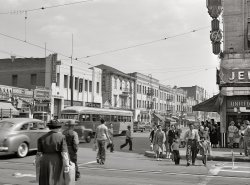
- Everything But War: 1941
- ... "Sign. Seaside, Oregon." Medium format acetate negative by Russell Lee for the Farm Security Administration. View full size.
Cooler than I ... Posted by Dave - 03/16/2022 - 3:12pm -
![Everything But War: 1941 September 1941. "Sign. Seaside, Oregon." Medium format acetate negative by Russell Lee for the Farm Security Administration. View full size.
Cooler than I thoughtAccording to weather dot com, at 6:30 pm EST (11:30 pm local time) today, it was 46 degrees Fahrenheit in Hell. Not too bad considering the rep it has for being hot.
Hell at HegraThe sign reflects a cruel irony. Nazi troops occupied Norway in April 1940 and stayed until the end of the war. The last effective military resistance, by volunteer soldiers, took place at the Battle of Hegra Fortress, April 15-May 5.
The village of Hell is less than ten miles from the site of the battle.
Man in the middleI wonder if Mr. Lee, standing on a remote Oregon beach, realized he was in the midst of world conflicts.
[His main assignment in September 1941 was documenting construction of the Umatilla Ordnance Depot in Oregon, vast repository for bombs and munitions used in the war against Japan. - Dave]
Paved the whole waySeaside could have sent them to Hell, Michigan instead - it's only 2,420 miles away.
Directional signI wonder where the custom of posting these directions to far away places originated. It seems to be a 1940s thing. I remember the one in Honolulu which I fear is no longer there. I remember them from several movies made around that time.
Re: Directional signIn the State of Maine, we have signs for places to go, and Presidents to meet.
Film sizeWhat dimensions are they calling "medium format"?
[3¼ x 4¼ - Dave]
(The Gallery, Bizarre, Russell Lee, Small Towns, WW2)](https://www.shorpy.com/files/images/SHORPY-8c22623a.thumbnail.jpg)
- Boys and Girls: 1941
- ... Idaho." View full size. 35mm nitrate negative by Russell Lee for the FSA. I see the makings here of a double date.
Brokeback ... Posted by Dave - 06/09/2018 - 9:29pm -
![Boys and Girls: 1941 July 1941. "Boys and girls. Caldwell, Idaho." View full size. 35mm nitrate negative by Russell Lee for the FSA. I see the makings here of a double date.
Brokeback Mountin' ?Note also the belt buckle moved to the left. This was common in that era, I am told.
[How fashion-forward. My own theory is that Ballcap is hauling his buddy around piggyback, maybe practicing for the Fourth of July picnic. Or it could be that his friend is just really, really clingy. - Dave]
From Caldwell to EternityThese two high school boys likely either enlisted or were drafted into the military after December 7, 1941. I hope they survived.
The girl in the mismatched outfit (stripes and plaid together?) seems to be thinking, "Gee, I wish he would hold me like that."
That black boxWhat is that? A radio? A small lunchbox maybe?
[It's a Kodak Brownie camera. - Dave]
Boys & Girls"He's Just Not That Into You," circa 1941.
What, no Onion?"So I tied an onion to my belt, which was the style at the time"
- Grandpa Simpson
Belts, BanksI used to wear my belt buckle a loop or two to the left as a schoolkid in the early 1960s.
I like the bank's hours. Closing at 3 p.m. weekdays and noon on Saturdays. Boy, they really had us in those days. That place must have been packed on Saturday mornings!
The BoysThose boys have to be brothers, right? Look at their eyes and noses.
[And ears. Shaped the same. Attention citizens (especially eightysomethings) of Caldwell, Idaho: Who are these people? - Dave]
Signs reflected in the windowThis is a wonderful photo; it captures a reality far from the experience of my family, and yet endearing and easy to imagine. I particularly like the expression on the face of the "huggee."
The stores across the street, reflected in the bank's windows, include:
* George's Shoes
* ??eurer's Cash Store
* No?????? & Sons (?)
[Meurer's Cash Store. Fascinating! - Dave]
Well...You have to admit that's one way to stay out of the Army.
Kodak BrownieHey, I have one of those cameras.
Great StudyI love the way each pair has a more "serious" member -- the boy hugging the other boy, while ostensibly "goofing around," seems to be looking quite intently at the cute girl holding the camera, who is also the more "serious" of her pair, with her girlfriend looking very diffident with her thumb to mouth gesture.
I can easily see a double-date with this quartet, in which plaid skirt girl and cap-boy are awkward and embarrassed, and camera girl and hugger-boy end up going steady, getting engaged and?
[I see three possible pairings here. - Dave]
Belt buckle to the leftIt's my understanding that belt buckles could be worn to the side for a couple of reasons. For musicians, it's so they don't scratch the backs of their guitars; for guys working on their hot rods, it's to keep the paint on the car from getting scratched if you're bending over to work under the hood. So an old musician/hot rodder/rockabilly boyfriend told me...
I love the repetition of all of the stripes, from her shirt, the columns and the reflected awnings, mixed with the squares, like the bricks, plaid skirts, windows and paneling.
Brothers?If this is the way "just friends"--or even brothers--interacted in the 1940's, I'm all for bringing back the good old days.
Banking HoursSomething in defense of the bank workers in those days:
My mother worked at a bank in the Netherlands in those days: after 3 p.m. there was a lot of work to do: All the accounting was done by hand. And on Saturday: if there was one penny of difference between debt and credit sides, they had to work in overtime until the difference was found (1 penny difference could have been caused by the difference of 2 bigger amounts), and the overtime was not paid to the workers!
Buckles and BrowniesI remember the older boys with their belt buckles to the side like that. It meant they were "cool."
Still have my Brownie camera like that, and the box for it. I haven't seen 620 film for it on sale for decades. It has two viewing windows, the one on top as seen in the picture is for vertical pictures. Another is on the side for horizontal ones. No flash, only one button to take the picture, and a little crank to advance the film. No wonder they were only about $3. But they worked well and were sturdy enough that Mom let me take ours to school sometimes. "You break it and your dad will tan your hide!"
Side buckledIn the early 60s I wore my belt buckled at the side after seeing West Side Story, like the guys in the film.
I think this is a great photo, very nostalgic, and it would be nice to think that all four of these people were still around. (Nicer still to think that they paired off.)
(The Gallery, Bizarre, Russell Lee, Small Towns)](https://www.shorpy.com/files/images/8a30220u1.thumbnail.jpg)
- The Texaco Troubadour: 1940
- ... the filling station and garage." 35mm nitrate negative by Russell Lee. View full size.
Looks well worn, that guitar, though no doubt ... Posted by Dave - 08/14/2012 - 5:04am -
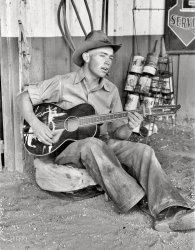
- Washday Blues: 1941
- ... Washday in South Side Chicago. 35mm safety negative by Russell Lee for the Resettlement Administration. View full size.
A Well-Dressed ... Posted by Dave - 09/09/2011 - 2:03pm -
![Washday Blues: 1941 April 1941. Washday in South Side Chicago. 35mm safety negative by Russell Lee for the Resettlement Administration. View full size.
A Well-Dressed GenerationWow.... nice dress, nice shoes ... Then again maybe it's the only thing left that's clean.
[The June Cleaver school of housework. - Dave]
Not Quite Candid CameraRussell Lee did not burst into her apartment and catch her by surprise. She must have thought that if someone was going to take pictures of her, she should look nice for the occasion. She succeeded, because we admire her clothes and her self-respect.
[She's a clerical worker at an insurance company about to leave for work. - Dave]
Grandma's houseA kitchenette apartment! My grandma lived in one during that time.
(The Gallery, Chicago, Kitchens etc., Russell Lee)](https://www.shorpy.com/files/images/8a29937u.thumbnail.jpg)
- Migrant Madonna: 1939
- ... in Wagoner County, Oklahoma." 35mm nitrate negative by Russell Lee for the Farm Security Administration. View full size.
Such a ... Posted by Dave - 05/17/2014 - 10:08pm -
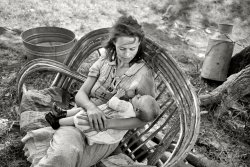
- Church Ladies: 1941
- ... in South Side Chicago. View full size. Photograph by Russell Lee.
Maybe sisters They all look pretty light...
Waiting I really ... Posted by Dave - 10/07/2012 - 12:28pm -
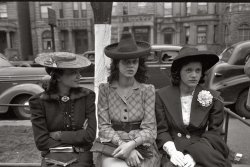
- Peer Pressure: 1942
- ... first aid class ." Medium format acetate negative by Russell Lee for the Farm Security Administration. View full size.
Stop the ... Posted by Dave - 04/23/2022 - 5:10pm -
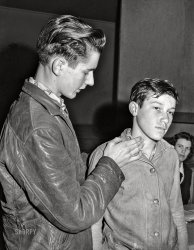
- Jim and Wife: Pie Town, 1940
- ... in Pie Town by Farm Security Administration photographer Russell Lee in 1940.
This Pie Town series is just This Pie Town series is just ... Posted by Dave - 12/14/2007 - 1:52am -
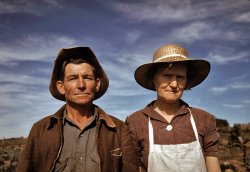
- Le Jeune: 1938
- ... lunches which they are carrying." 35mm nitrate negative by Russell Lee for the Farm Security Administration. View full size.
Lead ... Posted by Dave - 12/14/2011 - 4:24pm -
![Le Jeune: 1938 November 1938. Mix, Louisiana. "Negro children coming out of store on their way to school. Note lunches which they are carrying." 35mm nitrate negative by Russell Lee for the Farm Security Administration. View full size.
LeadDidn't know in those early days gas pumps carried the sign "contains lead." Did unleaded gas exist then?
[It's all unleaded until the lead gets added at the refinery. The warning "for use as a motor fuel only" means don't use it in a stove or heater, since lead is poisonous. Gasoline for cooking and heating, without additives, was called "white gas." - Dave]
Lucky kidsAt least they have shoes to wear to school. My dad was about the same age in rural Louisiana at the time and wasn't quite so fortunate. Shoes were a "sometime" thing for kids in the country.
Lunches were duly notedand I didn't see anything remarkable other than the girl got the better end of the deal food-wise. Could it be that African-American kids in rural 1938 Louisiana didn't often have lunches to carry?
PuzzlementThe photos is great for its detail of a general store, but I don't get the point about the Negro children's lunches. What am I missing?
SandwichIt looks like they've split a poboy.
AH... A Nehi sign ( grape anyone? ) and the obligatory Cocoa-Cola sign as well.
Also signs for "Old Gold, Camel, and Luckies Cigarettes" and for the roll your own crowd "ripple" and "Star tobacco as well. I think "Sensation" was a cigarette brand as well...
What You Could Have Bought For A NickelPepsi and Old North State Tobacco.
GasWith regard to an earlier comment: You could put unleaded "white gas" into your car as a fuel but then you'd have to break out your small can of lead additive to put in with it or your car would be jumping like a washer spinning with a lop-sided load of clothes in it. The sign on the pump let you know you were getting true motor fuel.
leaded gasWhen I was growing up we used to get unleaded or white gas for our Coleman lanterns when we went camping at the Amoco station. Leaded gas also had a pink dye added to it so you knew it had lead in it.
Re: Leaded GasBefore you had the choice of leaded or unleaded where I live, we had to go to the American Truck Stop (Amoco) to get white gas. Coleman Fuel was cheap then and we used that in our stoves and lanterns, but we used Amoco white gas in our 2 stroke motorcycles (they needed gasoline which Coleman Fuel ain't). When other oil companies offered unleaded we could get our white gas about anywhere though I don't think any of them were as good as Amoco.
(The Gallery, Gas Stations, Kids, Russell Lee, Stores & Markets)](https://www.shorpy.com/files/images/SHORPY_8a24785a.thumbnail.jpg)
- Or Else: 1938
- ... Complementary) Imperatives." 35mm nitrate negative by Russell Lee for the Farm Security Administration. View full size.
Eat rice, ... Coke I don't think the potential for humor escaped Russell Lee.
I see a lawsuit coming! I can hear Chick-fil-A's lawyers ... Posted by Dave - 03/22/2012 - 11:07am -
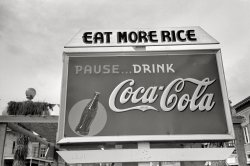
- The Summer of '41, 2.0
- A colorized version of Russell Lee's "Summer of '41," posted here in 2007. View full size. I wrote an ... in "Pleasantville"
(Member Gallery, Colorized Photos, Russell Lee) ... Posted by John Derry - 06/30/2009 - 3:00pm -
![The Summer of '41, 2.0 A colorized version of Russell Lee's "Summer of '41," posted here in 2007. View full size. I wrote an article for Rangefinder Publishing's AfterCapture magazine detailing my technique. You can download "Colorizing a Memory" here.
Nice work!I especially like the realistic flesh tones. They're among the hardest colors to get right.
Backyard BeachLove the grape Popsicle! Suntan oil came in a can??
[It's a can of Pompeiian olive oil. Click to enlarge. - Dave]
Colorization Sucks!No matter how good the so-called "artist" might be at it, it reminds me of the "fake stereo" records of my childhood, where classic recordings by Bessie Smith and Duke Ellington and Jelly Roll Morton and other 1920's, 30's and 40's musicians would be "enhanced" with echo-chamber effects, phasing, and other such audio fakery before they were sold as LP collections to a public that had never heard the originals.
Never mind that the original musicians and recording engineers had nothing of the sort in mind— this technical effing around was considered an "improvement" by the utter morons who were responsible for all those travesties.
Old saying, origin unknown: "If it ain't broke, don't fix it!"
A STUPENDOUS job.A STUPENDOUS job. And how bizarre that just adding color makes it look like it was only yesterday. Except for the swimsuits, which are a bit different, and the fact that people aren't actively TRYING to crisp themselves anymore (Olive oil!? -- I thought the baby oil phase was bad) people seem still much the same, lying around in the yard, goofing off.
Re: Colorization SucksNo doubt, some folks don't or won't like the idea of adding subjective color to a monochromatic image. However, it is a visual technique capable of revitalizing precious memories.
I've done colorizations for family members of deceased loved ones in which they wish to memorialize and remember the family member as they appeared in life.
Life is not black and white—it is in color. The addition of well-applied color to a b/w photograph is sometimes the only way to heighten the sense of life the subjects once possessed. The result is often emotionally overwhelming for the family members upon first viewing.
It's not necessarily a matter of "if it ain't broke, don't fix it.". Sometimes it's a matter of "if it adds life, enhance it."
Fun With ColorI enjoy seeing what can be done. No harm done, it's another way to have fun, and it brings out details you might miss in the original (per the grape popsicle). Advice to Colorists: never leave anything uncolored even if it is supposed to be grey (such as the concrete wall). Real life surfaces are mottled, and shadows take on subtle colors reflected from nearby patches of light. Aside from this, this picture is very convincing.
Little Pink Houses, or I Don't Believe in YesterdayWhy, exactly, should a photograph originally taken nearly 70 years ago look as though it "was taken yesterday"? What is gained? If an original photo was taken in black and white because color photography wasn't available or affordable to the photographer or just because he or she wanted it in black and white, I don't see how primping it up improves anything. I hope nobody goes after Mathew Brady's work with this process.
I couldn't disagree moreI couldn't disagree more strongly on the anti-colorization sentiments. The original B/W image still remains so where is the downside? The upside is an incredible view of the past that is more familiar to us or perhaps more consistent with our present context. I LOVE the colorized version. It transports me back to that time and places me in the picture for sure. It is like watching B/W WWII footage versus color footage. The difference is staggering.
Keep up the awesome work!
Color me impressedJohn, this is fabulous. I'm relatively new to colorizing, and while it's a lot of fun, I find my results a little disappointing at times. Thanks to your description of how you achieve more natural skin tones, I now know why. To all the colorizing detractors: colorizing an old picture is like being a kid and getting a new coloring book and a big box of Crayolas. It doesn't damage the original, for which the colorizer still has the utmost respect. It's just fun to see an old image brought to life by imagining it as we would see it had we been there to witness it in person. It brings a freshness and an immediacy to the image. We don't see in black and white. Tea said it best: "...adding color makes it look like it was only yesterday."
Mouthwatering...I mean of course the grape flavor popsicle. I have a small supply of grape soda imported from the US in the refrigerator for good humor moments like these and I'm gonna open one right now. Grape popsicles are a big part of my childhood memories of summer. Just like the small of Coppertone. or the taste of a peanut butter and jelly sandwich.
Great work. Thanks for the tutorial. You mentioned Kodachrome and the Alienskin plugin. I want to emulate Kodachrome so that color photos will look like the Kodachrome images here on Shorpy.
Even with the plug-in I've had no luck trying, the effect doesn't even come close. Any ideas?
Re: Kodachrome EmulationI'm pretty sure that whatever method Alienskin uses to approximate Kodachrome's "look" is based on modern samples.
The Kodachrome emulsion of 60 years ago was very different, with a color balance that favored yellows and reds. You could probably use the Alienskin Exposure2 plugin as a starting point, but you'd need to do additional color correction to dial an image's color to match the old Kodachrome look.
Purple BikiniCheck out the pipes on her!
Was she the local arm-wrestling champ, or something? Maybe the popsicle is part of her training diet.
Colorization goes back many yearsI have a photo that used to hang on my grandmother's bedroom wall that was colorized, in 1900. I am not sure if it was the photographer, or someone else, but whoever it was dated their work on the back. I haven't liked many of the colorized things I have seen online, because the colors are too bright, in many of them. There are a few that I like, though, including this one, and I certainly don't see any harm in it! If someone painted the original, and there were no copies, I would be upset, but I don't think there is anyone here who would do that, anyway!
"Everyone is turning colors"So I'm guessing that the commentors who don't care for colorization were revolted by the movie "Pleasantville."
"What do you want to do to me right now? Come on. Everyone is turning colors. Kids are making out in the street. No one is getting their dinner. Hell, you could have a flood any minute! Pretty soon, the women could be going off to work, while the men stayed at home and cooked!" -- David in "Pleasantville"
(Member Gallery, Colorized Photos, Russell Lee)](https://www.shorpy.com/files/images/summer.thumbnail.jpg)
- Enchanté: 1937
- ... Joe Kramer, farmer near Williston, North Dakota." Photo by Russell Lee for the Resettlement Administration. View full size.
Little did ... Posted by Dave - 07/09/2013 - 6:43pm -
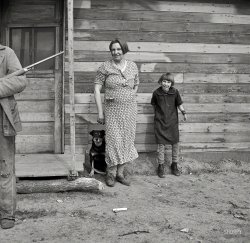
- Beer's Here: 1941
- ... for storing munitions.) Medium format acetate negative by Russell Lee. View full size.
It's that easy with the men Beer on the ... Posted by Dave - 03/20/2022 - 11:56am -
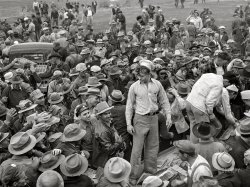
- Log Train Running: 1941
- ... Perce County, Idaho." Medium format acetate negative by Russell Lee for the Farm Security Administration. View full size.
Hardpack ... Posted by Dave - 02/08/2022 - 4:52pm -
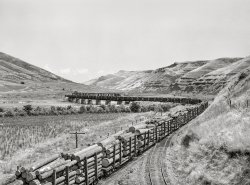
- Two Dolls: 1936
- ... View full size. Medium format nitrate negative by Russell Lee.
Edgar Allen Household No doubt Mr. Allen and his wife (if there is ... Posted by Dave - 09/09/2011 - 2:38pm -
![Two Dolls: 1936 December 1936: "One of Edgar Allen's children playing with doll. The couch and sewing machine are the two most substantial pieces of furniture in the house. The farm is one hundred sixty acres and rented from private party. Near Milford, Iowa." View full size. Medium format nitrate negative by Russell Lee.
Edgar Allen HouseholdNo doubt Mr. Allen and his wife (if there is a Mrs. Allen) were exhausted from farming 160 acres. But that house looks like it hasn't been cleaned in years. If a six-year old could shuck oysters or work in a textile mill, the Allen children could certainly push a mop and use a dust cloth. I don't mean to sound judgmental, but it's hard for me to feel any compassion for this family, poor as they may be. Maybe we will see some more photos of them that may alter my thinking.
The Allens AgainThere are more pictures at the Library of Congress. These people were fighting for their lives and probably not concerned with dust on the floor.
1936 was a hard year to be clean in IowaThe middle part of the United States suffered drought in the mid-1930s, with 1935 and 1936 being particularly bad. Dust storms would have coated this house and dust may have worked its way in through the walls, around the windows, caking the clothing of everybody who lived there.
The entire family was probably working long hours in conditions of particular dust and dirt, in a house that could not keep that out, in an era before vacuum cleaners.
Besides, why should cleanliness be a qualification for compassion?
The AllensI don't think it serves any good purpose to judge these people, whom we know almost nothing about, other than several 70-year-old photos, and Russell Lee's brief comments. Under one of the other photos of the Allens, a touching portrait of the whole family, Lee says: "Edgar Allen, wife, and children. They are tenants of private party on one hundred sixty acre farm near Milford, Iowa. Crop share lease, two-fifths of all crops and two hundred dollars rent. This is an extreme case of poverty in northwest Iowa. Children are very smart and seemingly very happy."
Cut them some slack.
1930's VictorianaWhat I find interesting about this picture is that it was taken in 1936, yet the decor looks more like the 1890's or 1900's.
I realize the couch may be as late as 1910, and that they didn't have the money to replace large items like this.
But even the art prints on the wall seem to convey an older time and place. The "New Home" sewing machine adds a level of irony. All of this is to say, our mental image of "1930's" may feature progressive streamlining in autos and architecture, but many folks lived daily lives with a far more traditional appearance.
Allen HouseFor a 1930s farmhouse, I think it looks pretty good. Even in modern times, try keeping a country home dust-free with all the dirt blowing around and getting in through every nook and cranny. To this day, we set the table with the glasses turned upside-town until they're ready to fill. It's a habit picked up from my grandmother, who developed the habit herself while living on a Dustbowl-era Kansas farm. She said that you had to do it that way to keep the dust out.
Ever Heard of The Dust Bowl? From the previous commentator:
"But that house looks like it hasn't been cleaned in years."
The house was probably cleaned and dusted the day before. Did you see that this picture was taken in 1936 in Iowa? It was called the the Dust Bowl for a reason. My grandmother grew up on a farm in Kansas during this era. She said there was always a fine layer of dust constantly. It was in your hair, on your clothes and they would moistened rags and stuff them in the crevices of the windows to try to keep the dust out.
Re: Edgar Allen HouseholdAs the original commenter on the Allen household, I am duly chastened by the responses. You have made me see that my comments were ill-considered and inappropriate. I offer my apologies. A Lesson Learned for me. Thank you.
HousekeepingJust looking at that messy pile of clothes on the couch, I'm sure glad no one is taking photos of my house as it is today.
We live in a rural area. Ants coming out of hibernation and mud coming in on shoes are the issues today. Dust will be the issue in the summer. Clutter is a year-round problem.
Heavy dutyThat is some gesundten sofa! I don't think even house construction is that solid nowadays!
True GritMy 86 year old grandmother, who grew up in the sandhills of Nebraska during the 1930s, describes pinning wet tea towels to the screen door in an attempt to keep the dust out during the dead heat of a depression era summer.
Also, I'm wondering if the surface of the floor is more worn down than dusty. It is unlikely that the residents of this farmhouse could have popped on over to the Home Depot to rent a floor sander and some polyurethane to refinish their floors or a Swiffer for daily maintenance. For a lot of people living in the 1920s and 1930s, wooden floors were a hard-to-maintain nuisance. A lot of people also felt that bare wooden floors signified poverty. If you look at housekeeping and homemaking magazines from this era, there was a big trend in covering wooden floors with large rugs or with linoleum and asphalt tile.
NostalgiaTwo things about this photo intrigue me. The first is the vintage sewing machine. My mother had one of these 1912 models from as far back as I can remember and right up until she died in the 1980s. When I was very little, I used to sit on the pedal and rock. If I could get it going, it continued rocking for several seconds, providing me with a little ride. My sister has that machine now.
The other thing is the moonlit lakeside picture in the upper right corner. The scene first caught my imagination at a neighbor's farm house when I was a little boy, circa 1954. It must have been a popular scene, for I've seen it on a lot of other items since then. I found a marred but framed large print of it at a flea market in the 1980s and have it put away for safekeeping.
It's still a beautiful picture to me, and I've love to know more about it. Its title is "My Blue Ridge Mountain Home", artist unknown.
ElectronicsThey probably have a radio somewhere. There's a vacuum tube on the window.
Dust and DollsThose commenting about dust know what they are talking about. I spent most of my life in Florida where my furniture seldom got dusty and sand on the floors was "clean dirt" easily removed. I now live in rural NC and could dust *hourly* during dry summer spells.
Granted that most photos are, to some extent 'posed', this one surely is. The girl is entirely too old to be playing with dolls, even in the 30s (I think I see a hint of a bosom there.) and certainly too old to let a doll get in such deplorable shape. That doll has been loved nearly naked by a small child.
Also, the girl is wearing a clean, ironed, possibly new, dress, not something she'd be wearing to play in.
However, I think the contrast of the spic-and-span dress of the child with the obviously well-used furniture makes the picture unusually poignant...which might have been what the photographer had in mind.
I really like this one.
Sand hills of NebraskaI will guess that your grandmother and my dad may have at least known of each other. My family homesteaded up in the anselmo/merna area.
Old House & Young GirlI think this house was built in town not the country. You can see walls have parted from dry weather, letting sunlight shine through the wallpaper in the corner.
The girl's dress may be a gift from someone who wanted a picture of her wearing it. The coat & clothes nearby could be her only belongings, with her doll from childhood. The room looks like it was not used for awhile, but will become her bedroom. Her appearance & clothing piled beside her made me wonder if she had been adopted from the Adoption Train. Perhaps a new dress was purchased on the way home to reassure her she was wanted.
[She's not adopted. The Allens lived in a rented farmhouse on 160 acres. See photos and captions below. - Dave]
Winter fuel supply on Edgar Allen farm. They hauled old stumps from highway construction, being too poor to buy fuel. This family is being helped by Resettlement Administration, one hundred sixty acres, crop share lease -- two-fifths crop, two hundred dollars rent. Allen has had poor crops and has been ill with bronchitis. Near Milford, Iowa.
Edgar Allen, wife, and children. They are tenants of private party on one hundred sixty acre farm near Milford, Iowa. This is an extreme case of poverty in northwest Iowa. Children are very smart and seemingly very happy.
Not badActually that's pretty clean compared to my house. We live in a small trailer and clutter accumulates easily. They sure did have a hard life, didn't they?
(The Gallery, Kids, Russell Lee)](https://www.shorpy.com/files/images/8b30034u.thumbnail.jpg)
- Future Farmer: 1941
- ... in wheat fields of Whitman County, Washington." Photo by Russell Lee for the Farm Security Administration. View full size.
Agro-Style! ... Posted by Dave - 02/25/2022 - 1:10pm -
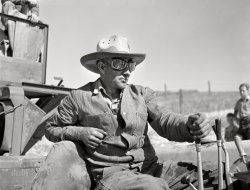
- Nurse's Orders: 1940
- ... Fria migratory labor camp, Arizona." Acetate negative by Russell Lee. View full size.
Product placement Russell Lee's assistant accidentally found the best spot in the composition to ... Posted by Dave - 05/03/2020 - 5:01pm -

- Customized: 1941
- ... Wilder, Idaho." Medium format acetate negative by Russell Lee for the Farm Security Administration. View full size.
You dear boy ... Posted by Dave - 04/08/2022 - 1:45pm -
![Customized: 1941 November 1941. "Migrant agricultural worker in his automobile. Wilder, Idaho." Medium format acetate negative by Russell Lee for the Farm Security Administration. View full size.
You dear boyBarbara Jo Allen played spinster Vera Vague, described as "sort of a frustrated female, dumb, always ambitious and overzealous … a spouting bureau of misinformation" ... reminds me of a few females in popular culture today but I'll refrain from naming names. One of Vera's catchphrases was "You dear boy!"
That being said, I'm not sure what to make of the mini museum of chains and trinkets hanging from the headliner of this dear boy's vehicle. He had a unique creative vision, that's for sure.
I Hear MusicAfter looking at this young worker's collection of decals and stickers, I am reminded of that old Hank Snow piece, "I've Been Everywhere".
I learned something new.Union 76 gas stations had decals for all the different towns in which the stations appeared. Some of the vintage decals are still available on eBay.
Right hand drive?Photo flopped?
[If the photo was flopped, the writing on the decals would be backwards! The steering wheel is on the left. - Dave]
Spent some time in the Willamette ValleyA number of those town stickers are within a 20 mile radius, and back then quite farm-centric (even now, although a lot of farmland is turning into subdivisions at an astounding rate). They'd be working everything from strawberries to hops.
(The Gallery, Cars, Trucks, Buses, Russell Lee)](https://www.shorpy.com/files/images/SHORPY-8c23048a.thumbnail.jpg)
- Triple Feature: 1939
- ... because you deserve it, and so much more. Photos by Russell Lee for the Farm Security Administration. View full size.
Darned youth ... Posted by Dave - 05/02/2012 - 9:54pm -
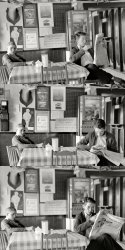
- Speed Dating: 1941
- ... rink. Southside, Chicago, Illinois." Acetate negative by Russell Lee for the Farm Security Administration. View full size.
New Title? ... Posted by Dave - 09/26/2018 - 10:01am -
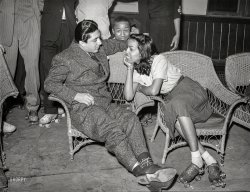
- Hustling Hermiston: 1941
- ... for the Umatilla Ordnance Depot ." Acetate negative by Russell Lee. View full size.
Making Progress Times sure have changed. You ... Posted by Dave - 03/16/2022 - 12:09pm -
![Hustling Hermiston: 1941 September 1941. "Traffic on main street of Hermiston, Oregon. Defense boom town housing workers for the Umatilla Ordnance Depot." Acetate negative by Russell Lee. View full size.
Making ProgressTimes sure have changed. You used to have to grow turkeys?
Eyes rightThe guy in the front car (of five going each direction, plus a bus, woo hoo) facing the camera sure seems to be checking out something or someone over to his right. They/it were/was not in the line of sight of Mr. Lee's lens, more's the pity. The bespectacled and kerchiefed (or hatted) lady in the car just behind him and to his right, however, had an avid interest in either the photographer or his doings. Her female passenger was eager to scooch over and check him out, too.
Eat what?Somebody's gotta do it: I'm surprised nobody has said anything about the SH??SHOP.
Flying A Gasoline Both window stickers on the trailing auto driving away, are in reference to,
the Tidewater Associated Oil Co.'s Flying A Gas. "Let's Get Associated" poster stamp series. Which were issued in the 1930s
https://www.ebay.com/itm/403405260042
Kool AirEver been in Hermiston in the middle of Summer? I have. Trust me, the "Air Conditioned" bus and also the cafe on the right would have been the place to be.
Two "EAT"and two "FOUNTAIN", signing must have been expensive.
"Let's Get Acquainted"is what the small sign says, in the back window of the boxy older car in the center of the photo. Any idea of what it means? An advertisement slogan that everyone would understand?
[Let's get ASSOCIATED. A brand of gasoline. - Dave]
Still there!Amazing as it seems, the Hermiston Herald still exists after 116 years.
Still a busy little block
Survivors on the left, once a newspaper office, now shared by a dress shop and a church. Spots to lounge, have dinner, or lunch, are still there. A computer store, wellness center, and an antique store now appear. Bet that antique store has a few items from the early 1940s. I do wish they'd kept the angle in parking. Looking the other way, East Main is closed off to traffic for alfresco dining, courtesy Covid. Hopeful in 2022.
(The Gallery, Cars, Trucks, Buses, Russell Lee, Small Towns, Stores & Markets)](https://www.shorpy.com/files/images/SHORPY-8c22749a.thumbnail.jpg)
- Trunk Line: 1941
- ... Perce County, Idaho." Medium format acetate negative by Russell Lee for the Farm Security Administration. View full size.
... And Some ... Posted by Dave - 02/27/2022 - 5:03pm -
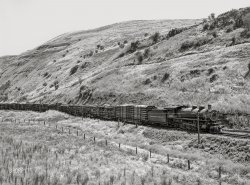
- Home Sweet Hovel: 1936
- ... her baby. View full size. 35mm nitrate negative by Russell Lee for the Resettlement Administration.
Shantytown Shack Wow, the ... Posted by Dave - 09/09/2011 - 6:50pm -
![Home Sweet Hovel: 1936 December 1936. "Mrs. Charles Benning sweeping steps of shack in Shantytown. Spencer, Iowa." Seen earlier here with her baby. View full size. 35mm nitrate negative by Russell Lee for the Resettlement Administration.
Shantytown ShackWow, the inside picture looks a LOT roomier!
Shack LadyInteresting, that the inside of the place looked so much neater than the exterior. The only thing she had left is whatever dignity she could muster. The interior shot showed the made bed, a cleanly clothed child, curtained window and Mrs. Benning looking fondly at her baby. I hope her life improved and the child grew up in better circumstances. That the depression didn't kill the spirit of our country is a tribute to people like her.
WiredIt is interesting to note the different sets of wires in the photo. One set seems to be going to this shack itself. Note the light bulb over the doorway, so they had electricity despite the poor circumstances.
Dynamite PhotoLooks like one of the front steps is made from an old TNT container.
Watch that first step!Looking at the protruding metal above the "dangerous" box, I wonder if this shack might not have begun life as some sort of truck body. That looks like it could be a heavy chassis, and the detritus next to the shack includes a steering wheel and an auto or truck cab.
Sort of "I drove it as far as it would go, and now we're stuck here!"
[The protruding part is wood, not metal (below). The little shacks were dragged around by horse team. - Dave]
Cook shackThis is a cook shack that was towed by a steam tractor. The curved roof matches the canopy of the engines. Threshing crews used these for food prep and storage.
(The Gallery, Great Depression, Russell Lee)](https://www.shorpy.com/files/images/8a21443u1.thumbnail.jpg)
- Garden House: 1942
- ... of agricultural worker at their garden house." Photo by Russell Lee for the Farm Security Administration. View full size.
Tyke Trike ... Posted by Dave - 04/23/2022 - 1:20pm -
![Garden House: 1942 February 1942. Woodville, Calif. "FSA farm workers' community. Son of agricultural worker at their garden house." Photo by Russell Lee for the Farm Security Administration. View full size.
Tyke TrikeSky King is another candidate for the tricycle - the back comes to a point like the one in the picture. I get the impression there were lots of competitors offering streamlined tricycles. It looks like the trike in the picture was rode hard and put away wet - paint and decorations are missing - but the boy seems satisfied with it.
I Like TrikeNever have I ever seen such a cool tricycle. And the tiny house looks very nice too.
Art moderneNever have I seen a streamlined tricycle that might have been designed by Raymond Loewy. If you had it today, it would be worth a bundle. I hope this kid appreciates it.
1935 Designer TrikeComplete with electric siren, even has wing-shaped pedals ... fabulous!
https://onlinebicyclemuseum.co.uk/1935-american-national-streamline-velo...
[That is fabulous, but not the same as the trike in the photo. Which has a streamlined "tail" for the body, in addition to the wheels. - Dave]
Very nice home designI like the simplicity, the large windows , and even a nice sunshade-trellis overhead with potential. Fast forward 50 years to the 5000 square-foot McMansions with only three living inside, with 32,000 sq ft of giant roofs, and rooms no one would ever use in a lifetime.
FarmvilleThe Woodville Farm Labor Center is still active today, with "one-hundred-seventy-eight 2, 3 and 4-bedroom units" available for agricultural workers. A New Deal site gave an address in Porterville, very near Woodville. The street view is of one house in the complex. There have been additions, but the windows have the right configuration. Unfortunately, the last time street view went through the area was 2007, so it's a little fuzzy.
(The Gallery, Agriculture, Bicycles, Kids, Russell Lee)](https://www.shorpy.com/files/images/SHORPY-8c23922a.thumbnail.jpg)
- Thresher Parade: 1941
- ... Department of Interior, Bureau of Reclamation." Photo by Russell Lee for the Farm Security Administration. View full size.
Seeing these ... Posted by Dave - 04/07/2022 - 12:14pm -
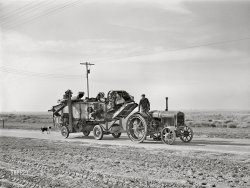
- Demand Gasoline: 1941
- ... a choice of Conoco DEMAND or BRONZ-Z-Z. Photo by Russell Lee, Farm Security Administration. View full size.
Keeping you dry ... Posted by Dave - 02/23/2022 - 2:38pm -
